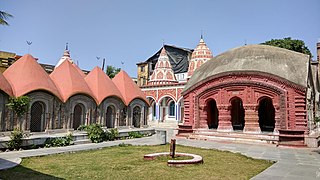
Murshidabad is a historical city in the Indian state of West Bengal. It is located on the eastern bank of the Bhagirathi River, a distributary of the Ganges. It forms part of the Murshidabad district.

Berhampore, also known as Baharampur, is a city and a municipality in the state of West Bengal, India. Berhampore is the administrative headquarters of the Murshidabad district. As of 2011 census, Berhampore is the seventh largest city in West Bengal. It is located about 200 km (124 mi) from Kolkata, the state capital.
Nabagram is a village in the Nabagram CD block in the Lalbag subdivision of Murshidabad district in the Indian state of West Bengal.

Murshidabad district is a district in the Indian state of West Bengal. Situated on the left bank of the river Ganges, the district is very fertile. Covering an area of 5,341 km2 (2,062 sq mi) and having a population 7.103 million, it is a densely populated district and the ninth most populous in India. Berhampore city is the headquarters of the district.
Lalgola is a census town in the Lalgola CD block in the Lalbag subdivision of Murshidabad district, West Bengal. It is situated about 225 kilometres (140 mi) north of Kolkata, near the head of the Ganges delta. It is a terminal railway station on the Ranaghat-Lalgola branch line. The distance between Lalgola railway station and Krishnapur railway station is one of the shortest distance between two railway stations in India (1.7 km). It is also a border checkpoint but presently non functional.

Nashipur is a village in the Murshidabad-Jiaganj CD block in the Lalbag subdivision of Murshidabad district in West Bengal, India.

Lalbag subdivision is an administrative subdivision of Murshidabad district in the state of West Bengal, India.
Domkal is a town and headquarters of the Domkal Subdivision in Murshidabad district in the Indian state of West Bengal.
Bhagawangola is a growing town with a police station, not identified in 2011 census as a separate place, in the Bhagwangola I CD block in the Lalbag subdivision of Murshidabad district in the state of West Bengal, India.

Jalangi is a village, with a police station, identified in 2011 census, in Jalangi CD Block in Domkol subdivision of Murshidabad district in the state of West Bengal, India. The village is situated along the bank of the Padma River.

Murshidabad-Jiaganj is a community development block that forms an administrative division in the Lalbag subdivision of Murshidabad district in the Indian state of West Bengal.

Sripat Singh College, established in 1949, is a college in Jiaganj, in Murshidabad district, in the state of West Bengal in India. It offers undergraduate courses in arts and sciences and postgraduate course in Bengali only. It is affiliated to University of Kalyani.

Kathgola Palace is a historical building belonging to the Dugar family at Kathgola in the Murshidabad-Jiaganj CD block of Murshidabad district. It now houses a museum.
Sagarpara is a village and gram panchayat in the Jalangi CD block in the Domkol subdivision of Murshidabad district in West Bengal, India. It is 2.5 kilometres from the Padma River.
Kasbagoas is a village in the Raninagar I CD block in the Domkol subdivision of Murshidabad district in the state of West Bengal, India.
Shaikhpara is a town, with a college, not identified in 2011 census as a separate place, in the Raninagar II CD block in the Domkol subdivision of Murshidabad district in the state of West Bengal, India. It is possibly part of Babaltali village in the census records. Babaltali is a big village with a population of 20,177 in 2011.
Kismattatla is a village in the Bhagawangola I CD block in the Lalbag subdivision of Murshidabad district in the state of West Bengal, India.
Baranagar is a village in the Murshidabad-Jiaganj CD block in the Lalbag subdivision of Murshidabad district in the state of West Bengal, India.
Rosnaiganj is a village in the Murshidabad-Jiaganj CD block in the Lalbag subdivision of Murshidabad district in the state of West Bengal, India.

Bhavaniswar Mandir, is located at Baranagar in the Murshidabad-Jiaganj CD block in the Lalbag subdivision of Murshidabad district in the Indian state of West Bengal.

















